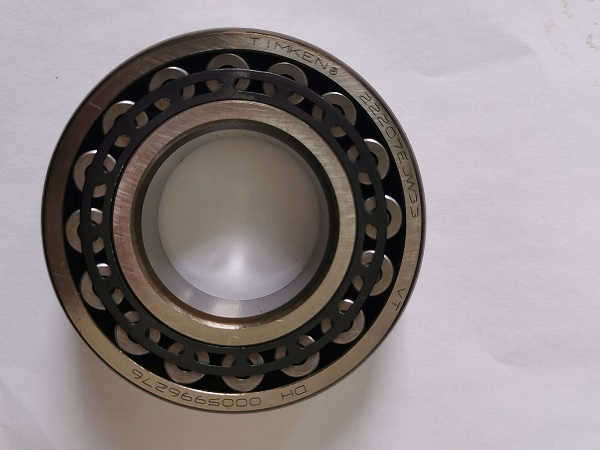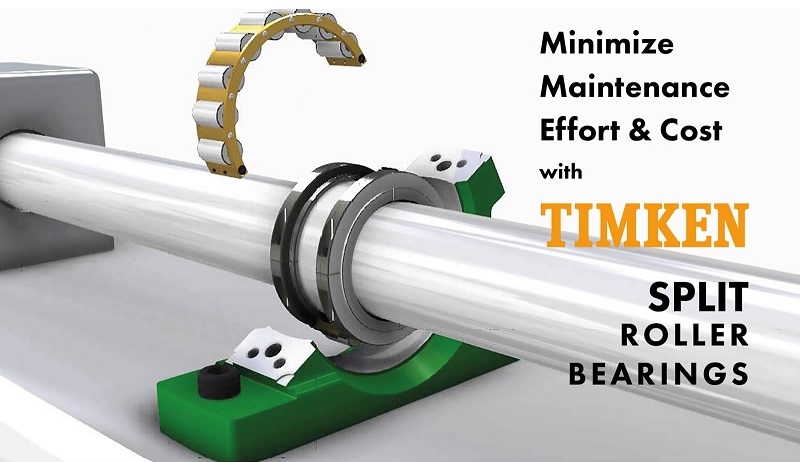Writer: Eric Bearing Limited
To accurately determine the degree of overheating, the microstructure must be observed. If coarse needle-shaped martensite appears in the quenched structure of GCr15 steel, it is a quenched superheated structure. The cause may be the overall overheating caused by too high quenching heating temperature or too long heating and holding time; or it may be due to the serious ribbon carbide in the original structure, which is between the two belts.
Quenching crack The crack formed by internal stress during quenching and cooling of bearing parts is called quenching crack. The causes of this crack are:
Because the quenching heating temperature is too high or the cooling is too rapid, the thermal stress and the tissue stress when the metal mass volume changes are greater than the fracture resistance of the steel; the original defects on the working surface (such as surface micro cracks or scratches) or internal defects in the steel ( Such as slag inclusions, serious non-metallic inclusions, white spots, shrinkage cavities, etc.) form stress concentration during quenching;Severe surface decarburization and carbide segregation of TIMKEN bearings; insufficient tempering after parts are quenched or not tempered in time; excessive cold punching stress caused by the previous process, forged folds, deep turning tool marks, sharp edges of oil grooves, etc. In short, the cause of quenching cracks may be one or more of the above factors. The existence of internal stress is the main reason for the formation of quenching cracks. The quenching crack is deep and slender, the fracture is straight, and the fracture surface has no oxidation color. It is often a longitudinal straight crack or annular crack on the bearing ring;
If the bearing parts are heated in an oxidizing medium during the heat treatment process, oxidation will occur on the surface of the TIMKEN bearing to reduce the mass fraction of carbon on the surface of the parts, resulting in decarburization of the surface. The depth of the surface decarburization layer exceeds the final processing allowance will make the parts scrapped.
The determination of the depth of the surface decarburization layer can be used in the metallographic examination of the metallographic method and micro hardness method. The arbitration criterion can be made based on the measurement method of the surface layer microhardness distribution curve.
Common quality defects of TIMKEN bearing parts after heat treatment are:
Quenching microstructure overheating, underheating, quenching cracks, insufficient hardness, heat treatment deformation, surface decarburization, soft spots, etc., TIMKEN bearing maintenance and repair methods. Overheating The microstructure after quenching can be observed from the rough opening of the bearing parts.
The importance of the TIMKEN bearing means that when it is damaged, it will cause the equipment to stop, so it is best to install a temperature detector for this type of bearing. Under normal circumstances, TIMKEN bearings will have a natural temperature rise immediately after lubrication or relubrication and last for one to two days.
Generally, bearings used at operating temperatures above 150° are called high-temperature TIMKEN bearings. When the chrome bearing steel exceeds 150°, its hardness will drop sharply and the size will be unstable, making TIMKEN bearings not work properly. Therefore, for TIMKEN bearings operating at a temperature of 150° to 350°, if the rings and rolling elements are still made of ordinary high-carbon chromium bearing steel, the bearing parts must be specially tempered, which should generally be higher than the Temper at 50°. ERIC BEARING can supply TIMKEN 22207 EJW33 bearings , pls click here :

After being tempered according to the above requirements, TIMKEN bearing steel can be used normally at the working temperature. However, due to the decrease in hardness after tempering, the life of TIMKEN bearings has decreased. When the working temperature of the bearing is higher than 350°, it must be made of high temperature resistant TIMKEN bearing steel.
Reasons for the high temperature of TIMKEN bearings:
1.The quality of bearing lubricant is not good, and the viscosity of lubricant is high;
2.The assembly of the mechanism is too tight and the gap is insufficient;
3.TIMKEN bearing assembly is too tight;
4.TIMKEN bearing race rotates on the shaft or in the shell;
5.Bearing load is too large;
6.TIMKEN bearing cage or rolling element is broken.
Choose TIMKEN bearing quenching method and cooling medium
Depending on the chemical composition, shape, size and mechanical properties of TIMKEN bearing parts, different bearing quenching methods can be used. Each bearing steel has its fixed C curve. The choice of bearing cooling medium determines the gold after quenching The phase structure and mechanical properties must be considered and analyzed in detail. In fact, the occurrence of heat treatment defects in many TIMKEN bearing parts is directly related to the choice of cooling bearing medium, and it is also related to the specific operation process.
After the work piece is heated to complete austenitization in the heat treatment furnace, in order to obtain the required structure and performance, it needs to be quenched. To obtain a martensite structure after cooling the workpiece, the cooling rate must be greater than the critical cooling rate. However, if the cooling rate is too fast, the volume of the workpiece shrinks and the structure changes violently, causing a large internal stress.
Therefore, in the condition of obtaining martensite, the cooling rate should be as low as possible, and the ideal cooling curve is shown in the figure.
Choosing a suitable quenching medium is particularly important. It determines the structure and performance of TIMKEN bearing parts after quenching. Generally, there are three kinds of quenching mediums: solid, liquid and gas. And no change in state.
New method of replacing TIMKEN bearing assembly
One is to use acetylene oxygen to directly heat the bearing; the other is to use oil immersion heating for small bearings to achieve thermal expansion and expand the inner diameter of the bearing for assembly. These methods have been widely used in long-term equipment maintenance, basically meeting and solving the problem of bearing assembly in equipment maintenance.
The second method is to ensure that the temperature value of the heated area of the bearing is uniform during the heating process, which is difficult to determine. Because the traditional acetylene oxygen heating is a single gas burner, and the heating process is only based on experience, it is difficult to grasp how much the temperature of the heated TIMKEN bearing is suitable.
If the temperature is too high, the bearing will be annealed, reducing the mechanical properties of the bearing; if the temperature is too low, the thermal expansion value is not enough, and it is difficult to assemble. In the repair of equipment, the repairman sometimes has insufficient heating of the TIMKEN bearing, and the TIMKEN bearing cannot be installed in the correct position, and he has to be forced to remove it for reassembly, thereby increasing labor intensity. To this end, we propose a way to change the traditional pair of bearings.
1.Use electric heating instead of acetylene oxygen heating. The flat electric furnace is designed as a cylindrical electric furnace, named TIMKEN bearing electric heater. According to different bearing inner diameters, it can be designed into bearing electric heaters with different powers and specifications (the best applicable range is bearing inner diameter φ300mm/more).
This heating device has the following advantages: uniform and stable heat radiation, no smoke and dust on the surface of the heated TIMKEN bearing, clean and clean, easy to measure and control the TIMKEN bearing temperature.
2.Infrared thermometer is used to monitor the temperature of the heated TIMKEN bearing surface. The heating value of bearing assembly is generally controlled at 100℃~120℃. Within this temperature value, the thermal expansion value of the bearing steel is the largest, which is convenient for the assembly of TIMKEN bearings. This temperature value will not change the mechanical properties of the bearing and has high reliability.

Matters needing attention when using TIMKEN bearings
1.Tolerance selection and control of shaft and TIMKEN bearing room: TIMKEN bearing should rotate flexibly without blocking after being pressed into the bearing. If the rotation is obviously not flexible, it means that the size of the shaft is too large, and the tolerance should be adjusted downward. If the bearing is pressed into the shaft and rotates by hand, there is a clear "rustle" feeling, it may be that the tolerance of the shaft is too large or the roundness of the shaft is not good.
Therefore, when controlling the tolerance of the shaft and the TIMKEN bearing room, the roundness should also be well controlled. At present, many domestic manufacturers only control the tolerance and do not control the roundness.
2.The assembly method of TIMKEN bearing: Because the bearing is a high-precision product, it is easy to damage the bearing channel if improperly assembled, resulting in damage to the TIMKEN bearing. When assembling TIMKEN bearings, there should be a special mold, which can not be knocked at will. When pressing into the shaft, only a small ring can be used to force, when pressing a large ring, only large rings can be used.
Air pressure or hydraulic pressure is required during assembly, and the upper and lower molds should be outside the horizontal state during press-fitting. If tilted, the TIMKEN bearing channel will be damaged due to the force, and the TIMKEN bearing will be induced.
3.Prevention of assembling foreign objects: When TIMKEN bearings are installed on the rotor for dynamic balancing, it is easy to get iron chips generated during dynamic balancing into the TIMKEN bearings, so it is best to do dynamic balancing before installing the bearings. Some manufacturers apply some oil or grease to the TIMKEN bearing room for lubrication during assembly, but it is often difficult for the operator to control the amount. If oil or grease is accumulated in the TIMKEN bearing room, the TIMKEN bearing When turning, it is easy to enter the TIMKEN bearing along the shaft. It is best not to apply oil or grease to the TIMKEN bearing room. If it is not necessary, it must be controlled not to accumulate in the TIMKEN bearing room.
Tel: 00852-30697500
Fax: 00852-30697511
Email: sales@ericbearing.com
Message: Click Here Message!